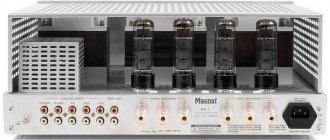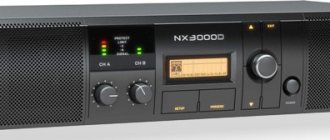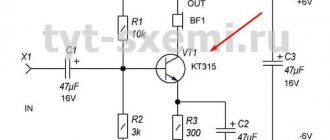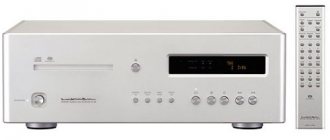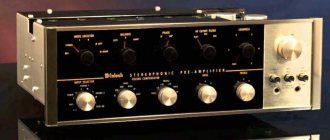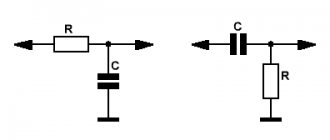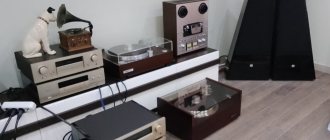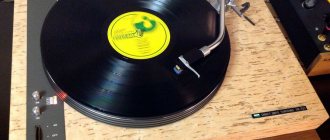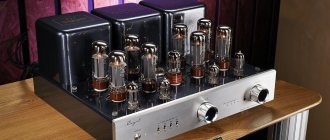Hybrid Hi-Fi amplifiers (tube-transistor) using the example of the Luxman line
SONY DSC I think it will not be a revelation to say that in the world of high-fidelity audio, apologists of two trends dominate - tube amplification and transistor amplification.
I won’t retell stories about harsh transistor sound and sweet tube sound - this is nonsense and a description of extremely low-cost setups and nothing more.
In an attempt to please Hi-Fi lovers of both movements, in 1985 Luxman introduced an original solution: the hybrid amplifier Luxman LV-105 at an extremely attractive price of 119,000 yen, as well as the less powerful model Luxman LV-103 at a price of 79,800 yen. The difference in weight between them was 400 grams, and both weighed 10 kg 200 grams and, respectively, 10 kg 600 grams.
The cheaper model had an output power of 80W+80W (6 ohms, 20Hz - 20kHz) and a THD of 0.008% (6 ohms, 1kHz), SNR 110 dB. The range of amplified frequencies extended from 1 hertz to 200,000.
Regarding the top model 105 - copy all the characteristics except the power, here it has increased to 105W+105W (6ohms).
What was interesting about this series was, of course, the unique hybrid amplification for the industry. The preamplifier ran on two triode tubes manufactured by General Electric, and the output amplification was assigned to high-speed MOS FET transistors - two emotional technologies in one bottle.
Electrically, the power supply circuit was designed in the shape of a star with a common point, which is well known from circuit design to many amateurs who make their own tube amplifiers. Luxman called this technology STAR (star - star in English).
In conjunction with the amplifier there was also a CD player with a tube output.
In this case, in the pre-amplification, the tube allowed for a linear, high-quality sound, which was driven by fast mosfet transistors, with which you can build very short audiophile circuits thanks to the unique properties of the MOS FET transistors themselves. I don’t remember if I’ve already talked about mosfets and what they are - if not and you’re interested, ask - I’ll expand this topic into a larger material.
Listeners noted the extremely emotional sound of these (103 and 105) devices, comparing them with top models of completely different price ranges.
But the history of this line was not limited to only the 103 and 105 models, and 5 years later, hybrid amplifiers still excited the minds of many audio lovers. Therefore, in 1990, Luxman repeated these models under the names LV-104U for the cheap model (89,000 yen) and LV-107U (135,000 yen) for the expensive one.
Copy the characteristics from previous models without changes. The weight of the 107th became 4 kg heavier, but this, I think, is not a consequence of the use of some other technologies, and the power supply became a little heavier, instead of a 170-watt one they installed a 185-watt one, and added two beautiful wooden sides to the sides of the device to give it a higher status apparatus.
Once again I will give the principle of operation of the device, but in English, if my words in Russian were not clear to anyone:
MOS FET is adopted as the power stage which treats 3 pole thermionic tube and a large electrical power in FET of a high impedance, and the driver stage at the first rank. The characteristic of a rich nuance original with the thermionic tube was pulled out, and the music representation with a very high quality is gained.
If you are not fluent in English, then just pay attention to the line “music representation with a very high quality.
Translation: “The music was presented in very high quality.”
The latest model of the Luxman A-384 hybrid series.
These are really very interesting devices and they would have remained in the realm of speculation, but I was interested in this hybrid technology and I got one such copy - Luxman LV-104U.
This is a large black device, with a transparent window on the front panel through which two tube triodes are visible. When you turn on the device, the threads in them gradually heat up and become orange. I’m already used to huge things weighing 20-30 kg, so compared to them it’s quite light, but still 10 kg is quite weighty.
I connected the Luxman LV-104U to the Diatone DS-501 acoustics, and the source was a DAC from China on Saber 9018 + 2xMuse8920+2xAD797+2xR-Core.
I listened to music both in Direct and with the help of enhancers like Loudness - the Luxman LV-104U has this ability.
The music is very emotional in presentation. Classical pieces - strings - simply convey emotions in an impressively deep way. You freeze with your mouth open and just listen. Those. The reviews did not deceive me - the device is sensual, I literally gasped. Of course, its disadvantages are also related to the technologies involved in it. For my taste, the resolution was average, which is not bad.
The second point is weak control of the lower register, which I have observed many times in tube amplifiers - a lot of hum that does not have an initial source. Therefore, the sound is of medium resolution with an amorphous bass, somewhat smeared, but with wild emotionality. From this we can assume that music lovers (especially lovers of classical works) and tube lovers should really like the device. I, alas, am an adept of surgical, literally cosmic precision and purity, speed and microdynamics, so for me this is just an interesting device based on hybrid circuitry with an emotionally impressive sound, but it doesn’t offer anything more.
Renaissance. Tube preamp and power amplifier Luxman CL-38u and Luxman MQ-88u
There is another addition to the line of the Japanese company Luxman: at the beginning of the year, the CL-38u tube preamplifier and the MQ-88u tube power amplifier appeared on the domestic Japanese market. According to established tradition, models are first released for the domestic market, and then, often with a fairly long delay, appear in other countries. Finally, we have the opportunity to test these devices.
Although the amplifiers were released this year, these devices have a history. And it’s not just the age of the Luxman company, which recently celebrated its 80th anniversary. These devices go back to the 70s and trace the lineage of their predecessors, who at that time were representatives of the company’s senior line. The use of successful developments of past years and the release of successful models from previous lines in an updated form are already becoming, to some extent, a tradition for Luxman. The recently released tube integrated amplifier SQ-38u and turntable PD171 were recreated based on previous experience, drawings and developments. I definitely like this trend, and the results of listening to these devices confirmed their serious sound qualities. And here's a new addition. The prototype for the CL-38u preamplifier was the 1970 CL-35 model, and for the power amplifier - the 1969 KMQ60 model, with the only difference that instead of 50CA10 output tubes (wonderful, but, unfortunately, no longer produced by anyone) in the modern version uses KT88 lamps. What’s interesting is that the predecessors of the models in question are well known to me, and they managed to live in my home system for some time, having been restored before arriving from Japan by an official service center. Memories of these devices are still alive, so comparison and testing turned out to be a doubly interesting task.
But first, let's look at the functionality and execution. Outwardly, everything is very similar to the 70s - a classic case, a wooden cabinet at the preamplifier, switches and controls that are the same in location and function. The preamplifier is entirely tube-based and also has a tube MM phono preamplifier on board, working in conjunction with built-in MC transformers. The tube set used is quite common for many preamplifiers - three ECC83 and five ECC82 tubes. The phono stage is built using an SRPP circuit. All switching, as is logical, is unbalanced. And here I found one drawback and one interesting point. The disadvantage is that the phono stage has only one input, and not two, as was almost always the case in Luxman models in the past. An interesting point is that the preamplifier has two outputs - maybe in the near future the company plans to release some tube monoblocks (fortunately, among the models of previous years you can find many worthy candidates for revival).
The external style of the devices takes us back to the 70s, and it is simply incredibly beautiful.
In terms of functionality, there is almost everything you need and even a little more - the switchable tone block completely replicates the previous design, although now few high-end manufacturers make tone blocks at all. There is also a low-pass filter, a mono mode and a recording loop, which I thought was more appropriate to use for connecting a headphone amplifier, since the preamplifier does not have its own headphone output. Then everything is quite familiar - a motorized volume control, a balance control, a mute button and a phono preamplifier selector, which allows you to select either two types of MC heads or a mode of operation with an MM head. The kit is complemented by a small remote control that allows you to adjust the volume or turn off the sound.
The power amplifier has unusual proportions, but this does not affect anything. Neither in appearance nor in functionality.
The power amplifier, operating in push-pull mode, uses one ECC82 and ECC83 tube in each channel, and a pair of KT88 at the output, providing a power of 25 W per channel. Additional functionality includes an adjustable input and, accordingly, its regulator. Everything is made much more carefully than is often the case with more expensive devices. The fit of parts, surface finishing, materials used - everything looks and feels very good. Even the light indication is made in such a way that it is not annoying at all. A dim yellow backlight of several small LEDs is used and that’s it, no frills. When examined from the inside, everything is no worse - a good element base, winding products of our own production, exceptionally neat installation - with all my pickiness, I could not find a single sloppy soldering. The location of all the nodes is thoughtful and logical, there is absolutely nothing to complain about. You can also praise the lamps. All of them are marked with the Luxman logo, so it is impossible to accurately determine their origin, but after changing everything in the amplifiers a couple of times, I came to the conclusion that the standard set is noticeably better than what is usually installed in many tube devices. Although, of course, it would simply be uninteresting to purchase such amplifiers and not bother with the selection of lamps.
Rear panel of the preamplifier. Everything here is laconic and familiar, with the possible exception of the presence of two outputs for power amplifiers.
Before listening, the devices had to be thoroughly warmed up; without this, testing anything is completely pointless. During the warm-up process, the sound changed several times before it began to stabilize; changes were audible, but overall did not cause irritation.
The power amplifier has regulated and unregulated input connectors, an input switch, acoustic and network connectors on the rear panel.
The first listening impression is partly predictable and partly completely unexpected. On the one hand, the devices turned out to have a completely recognizable Luxman style - exceptional attention to detail and delicacy. On the other hand, the sound is both tube and non-tube at the same time. Excellent microdynamics are complemented by excellent elaboration throughout the entire range. There is bass, but the kind that not every good transistor amplifier is capable of. Good scale and dynamics are complemented by simply amazing nuances. In general, everything that happens in the bass and mid-low range is a separate story. All components of bass, drums and percussion are perfectly audible - volume, speed, texture, spatial proportions, natural timbres. Even on complex symphonic recordings, loaded throughout the entire range, timpani remain timpani, and do not turn into inarticulate droning drums. The mid and high frequencies are also present in their proper place and in the required quantity. The sound is very detailed, but without a hint of corrosiveness, synthetics or harshness.
Precise handwriting and equal attention to both detail and music in general are the characteristics of this couple.
In the upper part of the range, there are no boundaries or compression at all, and a lot of nuances and shades are heard in the recordings, which are lost in many other systems. The scene is very cohesive, balanced, without bloat or distortion and with excellent depth, plans and arrangement of instruments. And this whole picture is complemented by excellent timbral authenticity, versatility of sound and richness of textures. True, this presentation in general also has its drawbacks. All recordings sound very different, you can clearly hear where, who and how they screwed up in the process. Here they pulled out the vocals and distorted them, here they simply strangled everything with compression, here they overloaded it with bass, here they forced the vocalist to “sing from behind the scenes,” but here everything is not bad. In general, the devices reveal each recording to such an extent that on some albums using non-acoustic instruments you can name the price of the synthesizer and the approximate budget of the project. The devices make it possible, on the one hand, to very accurately evaluate sound and recording, but on the other hand, they play music absolutely wonderfully and do not interfere with listening to it. The handwriting is so precise that I can switch from analytics to music 10 times during the playing of one track, and every time I will generally feel comfortable and hear what I need. This ability is actually worth a lot, and it reminds me of the best examples of technology of past years, those when serious studio equipment and High End were essentially the same thing and there was no demarcation between professional sound work and audiophile fads.
Internal structure of the preamplifier. Everything is done very carefully, and the details used are good. In the lower right corner you can see four installed step-up transformers for MC heads.
With genres and tube sound, everything is even more interesting. You can’t hear tube sound here as such, or you can say that you can hear the signature that is characteristic of very expensive tube devices, those that are essentially compared in sound to equally serious transistor devices, and the differences remain only in the nuances. In terms of genres, I listened to everything you can imagine - jazz, small classical compositions, symphonic and choral music, various kinds of electronics, classic rock, gothic, doom, black and other heavy metal.
The remote control is extremely simple - there is only a volume control and a mute button.
And I didn’t hear any formal shortcomings; the tract copes well even with very complex recordings. Moreover, the phono preamplifier installed in the preamplifier generally corresponds to the level of the circuit and produces the same signature. Unless with heads with a very low output of less than 3 ohms it is better to use an external step-up transformer.
One way or another, I haven’t come across a device that I liked so much for a long time, and this is taking into account that I’m generally not a fan of tube technology as such. But here what is heard is heard, and such integrity of sound still needs to be sought. Microdynamics and musicality are close to the level of a decent single-ended circuit, but the dynamics and scale are quite comparable to what, for example, a single-ended circuit with a 211 tube can produce. And with a good transistor kit, this pair can easily compete. To summarize, I note that the path is extremely sensitive to all cables, to power and reacts very sensitively to every change. The same applies to speaker systems, but I would not call this combination too capricious. I also connected the amplifiers to acoustics that were not the easiest to drive and did not notice any lack of control. In general, there is one thing. These are very serious adult components, and I would not recommend them to a beginner with unformed ideas about his sound. Also, I would not listen to publications of incomprehensible quality on such a system - all the shortcomings will be clearly audible and noticeable. These amplifiers can be an excellent basis for a serious system for an adult, accomplished and understanding audiophile and music lover who appreciates sound, but knows how to listen to music. Of course, you always want to actually see how the notes hang and dissolve in the air with sounds, and these devices can provide all this, but only if the source material was created by musicians and sound technicians with soul. If the recording contains rollicking semolina and cardboard boxes instead of notes and sounds, it will be audible and noticeable.
In general, the measurement results of both the devices individually and the combination as a whole turned out to be better than could be expected for tube devices, but quite consistent with what detailed listening showed. The HF roll-off is present, but it is less than what is statistically shown by tube technology, and the values of this roll-off are practically indeterminable by ear. The indicators for the upper operating frequency and decay turned out to be slightly different from the passport data, but this error is not critical. Other parameters did not cause any complaints.
